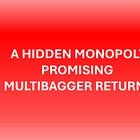My 100-bagger investing philosophy
It might not be what you think
Since I launched our paid tier about a week ago, I received some questions from you on my “investing philosophy”.
This article goes beyond the simple Yin-Yang strategy I outlined before.
Here’s how I approach the markets ⬇️
The groundwork
In the end, I distill every opportunity down into 3 questions:
How big is the downside risk?
Does it have a high probability of doubling in the next 5 years?
Is there more long-term upside potential? (100-bagger potential)
And luckily, up until now, an AI still sucks at answering these 😉
One of the most important concepts in investing is the notion of risk. (Probability X Consequence). Risk does not equal volatility.
Like in any game, we place bets. The risk level determines whether we take a bet and the size of that bet. Here’s where I got the inspiration for those three questions.
Question 1 comes from Seth Klarman, who wrote a great book called Margin of Safety. Since most investors look up before they look down, I like to start with the downside risk: How much can I lose, and what is the probability of that loss?
Question 2 is my hurdle rate. I cloned this from Buffett. This is the same question they ask when looking for opportunities. Of course, because of their large capital base, it is harder for them to find them (we can hunt for smaller companies).
Question 3 is the destination analysis, which comes from Nick Sleep. Where do I see this company in 10 years? What is its DNA? Is there hidden growth potential?
The above 3 questions determine if and by how much I place my bets. Each bet is based on the difference between the downside risk and upside potential.
You can look at it like this:
The company deep dive of last week typically sits in this category, with a yes to all 3 questions.
➡️There was some very positive news published yesterday, so the thesis has become even stronger.
But these questions say nothing about what I’m hunting for in the market.
The playbook
In comes the Peter Lynch playbook.
Peter has achieved incredible returns. Although he preferred smaller companies with high growth, he looked at all sorts of opportunities.
At a certain moment in time, while running the Magellan fund, he owned more than 1400 stocks. You cannot replicate this. Some of these were 0.1% positions.
What we can replicate is what he was hunting for.
Here’s the summary of his playbook ⬇️ He classified investment opportunities into “buckets”:
So I wanted to go a bit further and emphasize why the market is handing us these opportunities:
It’s important to understand the mispricing of each case. My current playbook identifies about 10 ‘buckets’. But let’s focus on 3 in particular ⬇️
1. What I aim for
I prefer to hunt for smaller companies with future high growth rates (the most fertile ground for multi-baggers based on past data). No matter how you look at it, a 100-bagger needs growth. If you can buy at a low multiple, then it can benefit from a multiple expansion. If not, you’re betting on its ability to compound returns.
But that doesn’t mean other interesting opportunities need to go to waste.
2. What I find on the side
There are other situations like net nets, turnarounds, or sometimes a spin-off or arbitrage play. (A hunter who goes out hunting for a big boar can also come home with other game)
I have a blueprint, the perfect setup for each one of these:
A net-net needs to be growing
A turnaround needs to be structural
And a spinoff has to be accompanied by forced selling
This allows me to quickly dismiss a lot of ‘situations’.
However, in these cases, it’s sometimes impossible to answer the 3rd question on long-term upside potential. But often, there is a higher probability of meeting our hurdle rate with lower downside risk.
Our bets then look like this:
These are interesting as they come along more often.
3. And occasionally, this happens
Sometimes, a crisis occurs, where a very high-quality (bigger) company finds itself spat out by the market.
These opportunities are rare (think Meta in 2022, and Adyen in 2023), but we do watch out for these as they come by. In the past, because of hubris, I decided to only look at small companies and set myself hard rules.
That was a mistake. My investing philosophy is evaluated each year to see if changes are needed.
In the end
It all boils down to finding companies we can hold for a long time, complemented by other, more short-term investments that meet the hurdle rate.
This process continues to evolve, but up until now, it has served me well in the past.
As one of you has mentioned in the chat, and I couldn’t agree more:
The 100-bagger is the destination. Finding a company we can just hold on to for a long time.
The above process is the journey. The way to get there, with the intent of meeting our hurdle rate.
I hope this clarifies some of your questions. I am writing an “owner’s manual” which goes into a lot more detail.
May the markets be with you, always!
Kevin








Yes, and because everyone seemed to be looking at more well known stocks. I changed my attitude since then.
Great article. Why did you only look at small companies in the past? Because you were only searching for 100-baggers?